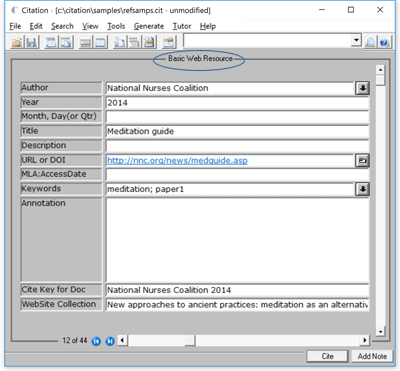| . |

Bibliography
A bibliography is any compilation of citations. It might include works consulted for a paper or a grant
proposal, or works to be included on a reading list, or works dealing with a particular topic. The principal
difference between a reference list and a bibliography, for Citation, is that bibliographies do not need to be
directly tied to the works cited in a document. Bibliographies are generated directly from the database;
reference lists are generated when Citation scans a document for cites.
More on bibliographies and reference lists.
Datafile or database
The collection of all the data records in a single file is a "database" or "datafile."
Field
A field is an area on a form designed to contain specific pieces of
bibliographic information (such as author names, titles, publication dates,
journal names).
Fields (which are the blank spaces) are labeled to indicate the type
of information that needs to be entered.

Form
A form is used to display the content of particular records. There
are different forms for different types of sourceworks. Each form
has fields for the particular type of sourcework.

More information on Citation's data entry forms.
In-text citations
These are citations that appear in the body of a paper, such as short form
cites - usually Author-Date or Author-Page (Smith, 1980),
numbered cites (1), footnotes, or endnotes.
The in-text citations refer to items in a reference list, and often include
pinpoint references to specific pages in the work cited, where quoted
passages can be relocated by a reader.
More information on
shortform Author-Date or Author-Page cites,
numbered cites,
footnotes, or
endnotes.
Publishing style
The publishing style is the set of rules used by Citation to structure the citation.
Standard publishing styles are predefined, and compiled with the program.
Custom format styles are editable, and can be changed to have your citations
conform to a citation guide not included with Citation.
The Standard publishing styles in Citation correspond to styleguides such as APA
or MLA and Instructions to Authors, defining the sequence in which bibliographic
information is placed in a citation, what print attributes will be used, how names
will be presented, and similar points of citation style.
More on publishing styles, and
the significance of publishing styles.
Reference list
A reference list is a compilation of bibliographic citations for all the works cited in a particular paper.
More on bibliographies and reference lists.
Record
A record in your database is like a page or a notecard. In your database,
you will have one record for each source work and each research note you
take. Records in the database are displayed on the screen using a
form
for the type of source work. (See either of the examples above.)
Search
Searching (or finding text) in Citation is very like searching for terms in a document
with your word processor, except that you will have a few additional options.
You can search for terms in a particular field, for instance, or in the entire
record. You could browse through all the records by a certain author, or
cases that were decided in a particular jurisdiction, or that contain a term
only in the keyword field or title field. Or, if you prefer, you could browse
through the records that contain a term anywhere in the record.
More on searching text,
browsing records containing terms,
and selecting subsets of records
matching search criteria
in Citation.
Select
Selection is a process for extracting a subset of records that match certain criteria.
You can select of subset of records, for instance, of all your notes on a particular
topic, all the articles published in a particular journal, court decisions dealing
with a particular issue, etc.
Any of the above Searches can be done as a Select - which means you actually
create a subset of your database containing only those records that match the criteria.
More information on selecting subsets of records.
Sort
Sorting is basically “ordering” records or citations by the contents of a
particular field. Citation supports a special kind of sorting for specifically
bibliographic resource materials, in which citations are sorted by Author,
Title, and Date, with unsigned works being sorted, then, by title.
Sorting is useful, however, for simply organizing your records to be viewed
in a certain manner. For instance, you could sort all the cases in your datafile
chronologically (this would be a sort on the Year field), or by the primary
keyword (this would be a sort on the Keyword field; records or citations
would be sorted by the first term in the keyword field.
More information on sorting records in Citation.
|


